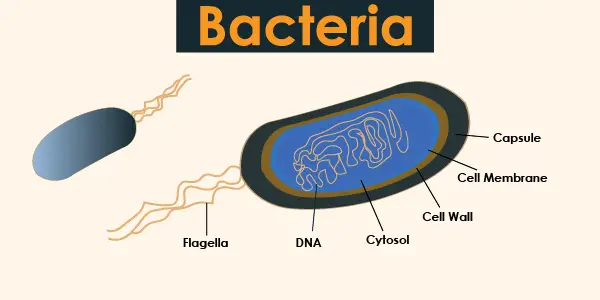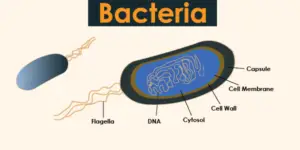
What are Bacteria ?
They are prokaryotic microscopic living organisms. They consist of a simple cellular structure and can live in different places and environments example: soil, oceans, and within the bodies of living organisms. Bacterias multiply by division, where a single cell makes a copy of its nucleic acid.

also read: difference between yeast and mold also compare and contrast yeasts and mold
Prokaryotes are organisms having cells without a nucleus. These are organisms that exist before the eukaryotes on the planet earth as the name Pro in prokaryote means before.
As every organism on earth has to reproduce the same as it. Bacterias also reproduce/divide but it has a different way of division. It uses asexual types of reproduction which is subcategorized into different types as binary fission, nuclear fission.
Bacteria Classification
Bacteria Classification: they have been classified according to different measures. There are two major divisions of bacterias which are Gram-Positive Bacteria and Gram-Negative Bacteria. Gram-positive bacterias have thick cell wall of peptidoglycan WHILE Gram-negative bacterias have thin cell wall of peptidoglycan.
Gram Stain
Gram Stain is a very common technique used to differentiate between the two types of bacteria. This method is based on the difference in the components of the bacterial cell wall where the bacteria is divided into two major classes Gram-positive bacteria and Gram-negative bacteria.
Gram-positive bacteria: They are stained with violet color. The reason for this is the storage of the violet color through the thick layer of the peptidoglycan present in its cell wall.
Gram-negative: They are red-colored, and the reason for this is that the purple color is not stored because the peptidoglycan layer in its cell wall is thinner.
Shapes of Bacteria:
There are three Shapes of Bacteria exist which are Spiral, Bacillus, and Coccus. Spiral bacterias have twisted shape, Bacillus bacterias have rod-like shape, and Coccus bacterias have spherical shape. Although, there is one more bacteria type called pleomorphic bacteria that can exist in several shapes.
Spiral: The type of bacterium with a spiral shape, many of which are solid, but able to move, and a distinct group of bacteria called spirochetes are included below, which are long, slender, and soft.
Bacillus: These are positive bacterias of rod-shape, that can be aerobic or anaerobic, and are widely found in water and soil, some of which may cause harm to humans, plants, and other organisms.
Coccus: These are gram-positive bacterias of spherical shape which are infectious pathogens in humans. It has several forms as streptococcus. These are leading agents in developing pneumonia, strep throat, food poisoning, meningitis, otitis media, and several skin diseases.
Flagella in Bacteria
Flagella in bacterias is also a factor for classification in them. Flagella is a tail-like structure found in some bacterias that helps to propagate or move forward. Bacterias possessing flagella are Monotrichous & Lopotrichous. Monotrichous are with single flagellum while Lopotrichous are with multiple flagella.
Bacterial Diseases
As there are bacterial benefits there are Bacterial diseases too. The bacterias that cause harm to the human body are called pathogenic bacterias, as the diseases caused by these bacterias are infectious in nature, and it can be dangerous with some complications that threaten human life to even death.
- Food Poisoning caused by Escherichia Coli (E-coli) and salmonella bacterium.
- Ulcers and gastritis, caused by H. pylori.
Gonorrhea, a sexually transmitted disease, is caused by Neisseria Gonorrhea. - Meningitis, which is caused by Meningococcal Neisseria.
- Wound inflammation, abscess, cellulitis, pneumonia, and other diseases caused by streptococcus bacterium.